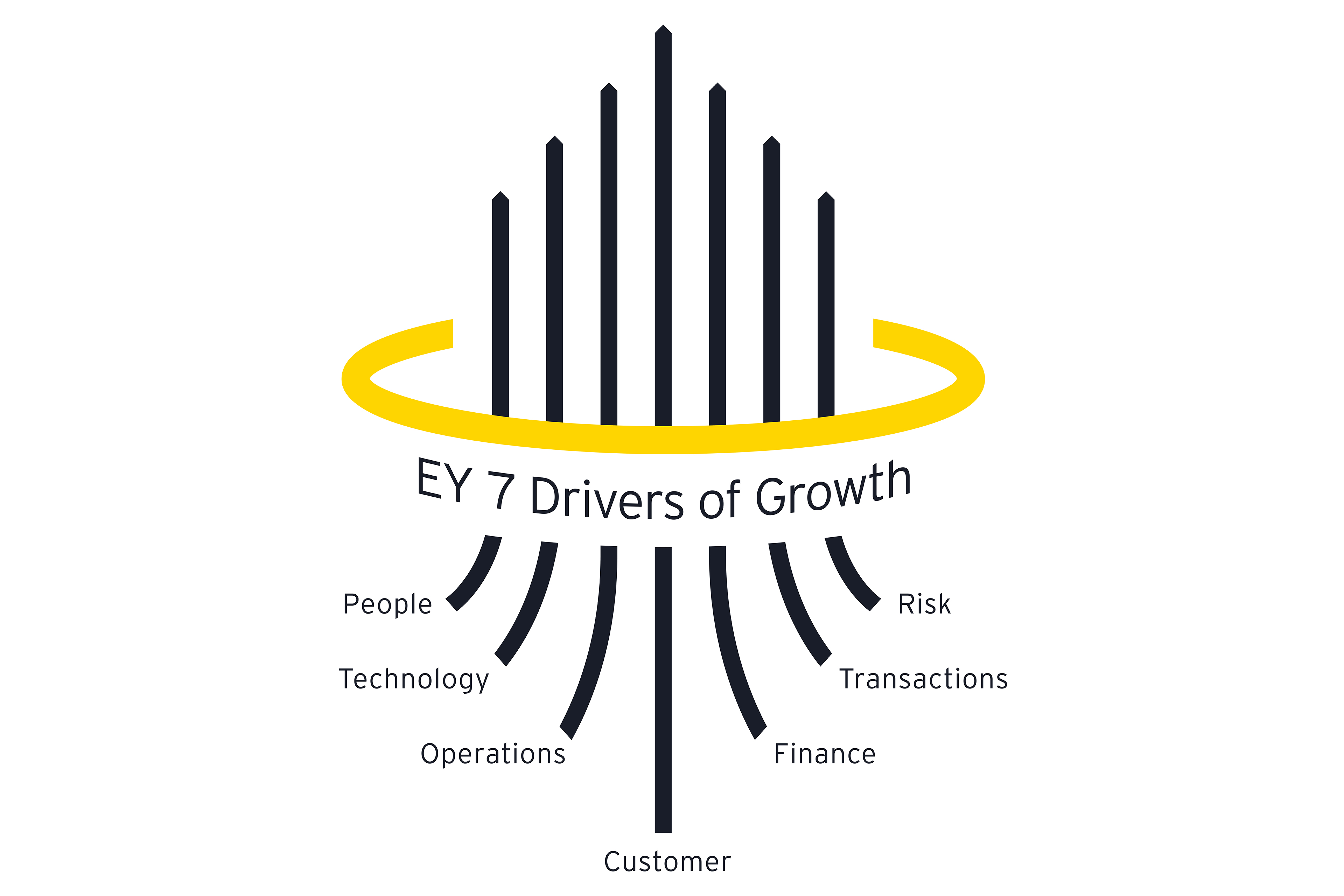EY refers to the global organization, and may refer to one or more, of the member firms of Ernst & Young Global Limited, each of which is a separate legal entity. Ernst & Young Global Limited, a UK company limited by guarantee, does not provide services to clients.

Entrepreneurial businesses are investing in new digital capabilities as they navigate an era of uncertainty and volatility.
In brief
- Private enterprises are building data-driven cultures, adopting analytics tools, and equipping their people with digital skill sets.
- Technology roadmaps are driven by the need to enhance customer and employee experiences, improve ecosystem effectiveness, and boost organizational resilience.
- The most successful technology transformations put humans at the center and enable technology adoption at speed and innovation at scale.
Technology will be a major focus area for private enterprises this year as they pursue growth in what is likely to remain a highly challenging economic and geopolitical environment. The latest EY CEO Outlook Survey January 2023 (pdf) found that nearly three-quarters (74%) of private company CEOs are planning to grow the digital and technology capabilities of their organizations. What’s more, they are more likely than their non-private peers to be increasing their investment in technology – the survey found that just 63% of non-private companies plan to accelerate their technology spend.
EY Private analysis of over 1,000 strategic growth plans created by the leaders of private companies from around the world highlights the following five technology-related themes as top priorities for entrepreneurial businesses looking to grow:
1. Enhancing data analytics capabilities and developing a data-driven culture
Data is critically important to private businesses. In fact, many consider it to be “the new gold”. Data provides the real-time intelligence that empowers private businesses to make better commercial and strategic decisions, run their operations more efficiently, and serve their customers more effectively. It also enables them to analyze past performance and make insightful predictions about future trends.
As an example, German e-commerce retailer Otto has been looking for ways to reduce its volumes of product returns and unsold inventory. It used a combination of artificial intelligence and analytics to analyze historical transactions so that it could more accurately predict future orders and automatically determine its procurement needs from third-party vendors. The outcome was that products were delivered faster (reducing the amount of time that customers had to rethink their orders), product returns were reduced by more than two million items a year, and surplus stock declined by a fifth.
As private businesses grow increasingly aware of the value of data, they are focused on enhancing their capabilities to rapidly capture, store, analyze and exploit both internal and external data. There is a strong emphasis on adopting real-time and predictive analytic tools, allowing private businesses to track customer behavior and needs, and improve business decision-making. To ensure access to consistently high-quality internal and external data, they are either introducing new enterprise data management and data quality processes or enhancing existing processes. Another key focus area is to develop or improve data governance processes so that data can be used, secured and shared across the organization while remaining compliant with data privacy regulations.
2. Development and deployment of the required technology roadmap
A technology roadmap is a planning schedule for technology adoption that supports the business to meet its objectives over time. EY Private research shows that the roadmaps of today’s private enterprises are strongly influenced by four driving forces:
Desire to interact more effectively
One driving force behind the Technology roadmap is to provide an enhanced and differentiated digital experience for customers, employees, and other stakeholders. For example, Rohlik Group, an e-retailer based in the Czech Republic, uses its unique data analytics, machine learning and artificial intelligence capabilities to offer 60-minute delivery times, or schedule the delivery in very precise 15-minute time slots, as well as highly personalized product offerings and real-time pricing. Through its Small Products & Suppliers Program, and its sophisticated tech- and data-led logistics chain, food now reaches customers within six hours of harvest instead of within days as per traditional retail. Rohlik Group’s key technology-led differentiators have resulted in a huge 70+ net promoter score and a 50% year-on-year growth rate, with the company having reached unicorn status in 2021.
Challenging economic circumstances
Having to deal with increased energy costs, supply chain disruption and rising inflation rates, businesses are deploying technology to become more resilient and agile, lowering their costs, and achieving higher levels of productivity and efficiency. For example, Haneda Airport, Tokyo, Japan, was one of the first airports in the world piloting and adopting so-called assistive technologies by means of their autonomous wheelchairs for travelers with mobility limitations. The wheelchairs can be called through an app, then destinations such as your gate can be entered, and the wheelchair will take you there without any further assistance required. Originally, Haneda Airport started adopting this new technology during the COVID-19 pandemic to solve for the problem of social distancing between the traveler and the assistant but discovered quickly that it also enhances the travelers’ experience due to a faster transportation service. Equally important, it significantly improved airport efficiency. Since then, it started adopting autonomous busses for traveler transfers to and from airplanes, and more recently autonomous towing tractors for cargo transportation, further improving efficiency, productivity and agility.
Ecosystem participation
As ecosystem adoption continues at pace across industries, there is more investment in making ecosystems a success by overcoming key technology challenges.
Overall, 91% of CEOs surveyed by EY teams for The CEO Imperative: How mastering ecosystems transforms performance agree that ecosystems have increased the resilience of their business. Nevertheless, critical challenges such as data integration, interoperability, and having a common cloud platform and cybersecurity for the whole ecosystem, require additional technology investments.
Aleph, a digital advertising enabler headquartered in Argentina and the United Arab Emirates, has demonstrated the power of technology in ecosystems by basing its entire business model around its own ecosystem. Through its “localized tech solutions”, Aleph connects thousands of advertisers across more than 90 countries, especially developing countries. Media platforms like Facebook, Instagram, and Twitter offer these advertisers a reach of three billion consumers. At the same time, Aleph enables its media partners to get access to advertising spend in countries that are harder to reach. Hence, Aleph’s technology infrastructure includes advertising campaign solutions, self-build online store services and cross-border credit and payment solutions, which form the bridge between entrepreneurs in underserved markets, global media partners and their large consumer base.
Business model disruption
More and more entrepreneurs are looking at how they can use technology to disrupt their existing business models and enable new ones, in an attempt to pursue further growth and be the first mover that potentially disrupts their whole industry model. As such, century-old, US-based spice company McCormick used an analytical platform to disrupt the spice industry. Faced with industry-wide saturation, McCormick combined its strength in creating world-class spices with big data and analytics to create a unique, digital recipe platform that understands customer tastes and suggests personalized recipes. This investment led to a 5% jump in sales within days after launch – an extremely high figure for a mature product category such as spices.
3. Enhanced cyber security and technology risk management
Cyber threats are a constant and ever-growing challenge for companies, especially since the rise of remote working has created new platforms and processes for attackers to exploit. The importance of cybersecurity has been heightened by entrepreneurial businesses’ desire to gather and capitalize on data as ”the new gold”, as well as stricter regulations around data management. In fact, the EY CEO Outlook Pulse ranked cybersecurity risk as the greatest risk to business after supply chain disruption, geopolitical tensions, climate change and inflation, bringing cybersecurity into the boardrooms of many private enterprises.
To combat cyber risk, private enterprises have prioritized their focus on the security and protection of data and digital assets, as well as other technological drivers of business growth. They are looking at how data is accessed and shared, both within and outside the organization, to ensure that it meets data privacy regulations. And they are investing in cybersecurity expertise, whether that’s building their own internal team or bringing in external talent from a specialist provider.
From a risk management perspective, and to support mid- to long-term security, private enterprises are focused on how they can enhance a security culture across the entire business. This includes setting the right tone at the top in terms of management accountability, embedding cybersecurity as a critical component of the company’s overall risk management strategy, investing in state-of-the-art security architecture, and defining procedures to limit the impact of a security breach. In addition, private enterprises are prioritizing a systematic technology risk analysis across people, processes, systems and organizational design so that they can implement an ‘active defense’ approach.
More and more companies are deliberately breaching their own IT systems to try to identify weaknesses and improve overall technology risk management. One example is Tesla, a company which invited hackers to try to breach the security of its vehicles in return for monetary awards. Once breaches are identified, the cars receive automatic security fixes where needed. The vehicle maker benefits from being able to avoid expensive recalls and negative publicity, and customer confidence and trust in its products is enhanced.
4. Build the right digital capabilities and skill set
Another key priority for private enterprises is to strengthen their digital capabilities by recruiting new talent and equip existing employees with the skill sets they need to use new technology in ways that foster growth and innovation.
The EY CEO Outlook survey found that 65% of private enterprises are retraining and upskilling their workforce to help them work with new technologies. Furthermore, over half (60%) are focusing their investment on innovation and R&D as they look to adopt and deploy new technologies in an agile way. For example, UK-based company Open Bionics, which produces prosthetic arms for amputees, has used design thinking and 3D printing to create artificial limbs that are attractive to children – the so-called “Hero arm”. From speaking to parents, it found that young amputees were put off using artificial limbs because of the peer bullying and stigma they faced. The cost and weight of the prosthetics were also causes for concern. To solve these problems, the company developed a 3D-printed arm that is visually attractive, functional, lightweight and 50% cheaper than similar products.
Furthermore, the role of the Chief Technology Officer (CTO) is becoming more prominent as private enterprises equip their CTOs with multidimensional mandates. These renewed mandates often include product and process optimization, influencing the customer experience, and mitigating business risk. There is a rise in transformation programs, with the aim of making the IT function a strategic partner to the C-suite. These involve an assessment of the required capabilities of the IT function, with additional specialist skills being brought in from external partners where appropriate.
5. Encourage digital innovation and experimentation
As they pursue growth, private enterprises are prioritizing the encouragement of digital innovation and experimentation – right across the organization. While they already have the benefit of an entrepreneurial spirit, the digital innovation agenda also requires them to develop an agile, data-driven, and experimental culture. They are rewarding their people for taking an analytical approach to experimentation. For example, US-based software company Adobe initiated a unique innovation program called “Kickbox”. The program incentivized junior employees to come forward with unconventional new ideas. Without any predefined qualifications to innovate, new ideas will always be pre-approved with a US$1,000 budget to build prototypes. Employees have the freedom to deploy funds as they deem fit and there are no rigid rules or requirements for progress reporting. A portion of Adobe’s annual innovation budget is earmarked for this program. It has resulted in the launch of Adobe’s Creative Cloud Libraries, an acquisition, and the development of multiple new tools and enhanced features for existing products.
Humans@center, Technology@speed, Innovation@scale
All the five technology-related priorities outlined above are indeed important to private enterprises. Nevertheless, as EY teams have learned, companies that create exponential value approach these priorities not individually, but rather as part of a bigger technology transformation program.
Leading organizations also understand that adopting new technologies will not be a one-off exercise. It requires an innovation “muscle” or core engine that sits at the heart of the business. They understand that they are not engaged in experimentation on the side. Instead, they have a deep-seated commitment to innovation that drives meaningful contribution to reframing the business. As a result, the entire business moves and adapts faster. For them innovation has become integral to the way the company operates and is a sustainable source of technological change.
Private enterprises that put humans at the center, deploy technology at speed, and innovate at scale will set themselves up to create exponential value through their technology transformation programs. They will also develop digital and technological capabilities that give them an enduring advantage in the market and the capacity to successfully navigate even the most challenging of times.
Food for thought – 10 key questions
Here are 10 thought-provoking questions for private-company leaders to reflect on as they reframe their technology strategy, thereby enabling technology to be a growth driver for the business:
- Should you be the one that disrupts or be the one that is disrupted?
- Is technology fueling your strategy or the sand in your engine?
- Does your organization have a clear technology roadmap for the next few years?
- Do you feel agile enough today when it comes to adopting new technologies?
- Do you feel you have a data-driven culture across your organization?
- How could eco-system collaborations support you in achieving your Technology ambitions?
- Do you know what your most critical digital assets are – and, if so, are they secure enough?
- Is digital innovation and experimentation being encouraged? And would your employees agree?
- Do your employees and stakeholders feel they are at the center of your technology transformations?
- Is your IT function currently an effective strategic partner to the C-suite?
Summary
Driving truly sustainable growth as a private enterprise is a big and complex endeavor that demands concentrated effort in several key areas. As well as technology, it is critical to focus on people, operations, customers, finance, transactions and alliances and risk. Through our research and work with the world’s leading private enterprises, we’ve learned that it requires balancing the company’s maturity across these 7 critical drivers to drive truly sustainable growth.
How EY can Help
-
Our 7 Drivers of Growth framework can help your business successfully execute your growth strategy over the long term. Find out how.
Read more
Related articles
How to escape the rollercoaster of constant strategic reprioritization
Successful business leaders know that with volatility comes opportunity. These three success factors can help to stay focused amidst constant change.
How can a strategic transformation mindset unlock long-term value?
Confident CEOs embrace corporate transformation mindset, using M&A and technology to navigate challenges and create long-term value. Read more.
The CEO Imperative: How mastering ecosystems transforms performance
Read the EY Ecosystem Study, a first-of-its-kind deep dive into how ecosystem mastery leads to higher performance.




